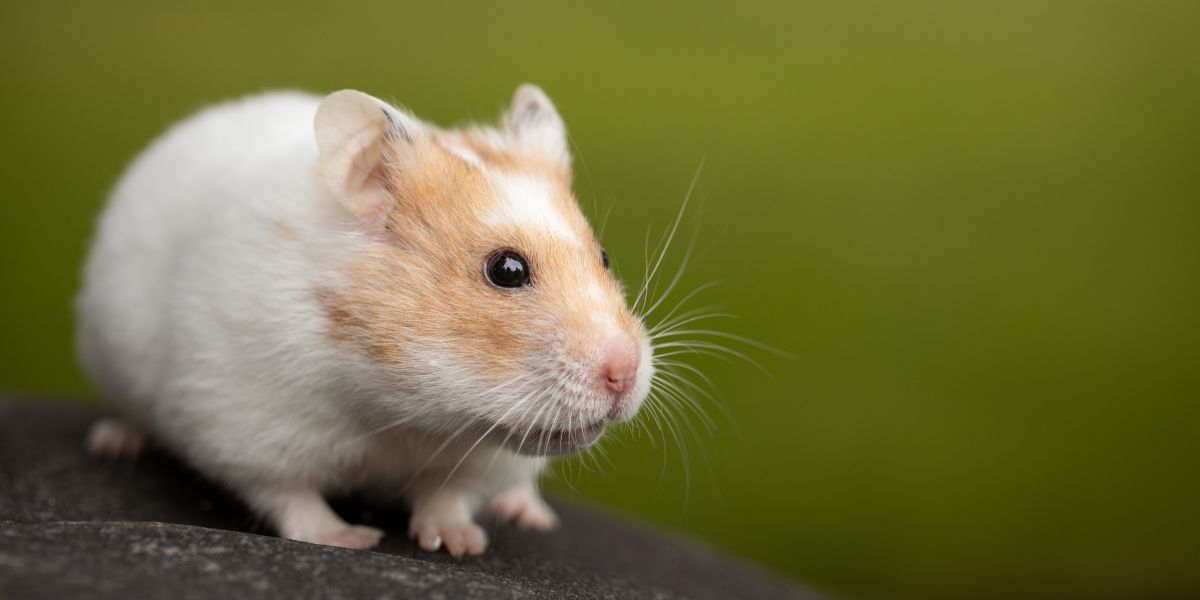
Hamsters come in various species, including the Syrian hamster (also known as golden hamster), Dwarf hamsters (such as Campbell’s, Roborovski, and Winter White), and Chinese hamsters. Each species has its own characteristics, but in general, hamsters are nocturnal creatures, meaning they are most active during the night.
These small mammals require a proper habitat with bedding material, hiding places, an exercise wheel, and toys to keep them mentally and physically stimulated. Their diet typically consists of hamster pellets, fresh vegetables, fruits, and occasional treats. It’s important to provide them with fresh water daily.
Hamsters have a relatively short lifespan, usually ranging from 1.5 to 3 years, although some may live longer with proper care. They are generally solitary animals and should be housed alone to prevent fighting, except for certain dwarf hamster species that can be kept together in pairs or small groups under appropriate conditions.

Overall, hamsters make adorable and low-maintenance pets, suitable for individuals or families looking for a small companion animal.
In which habitat does they live?
In the wild, hamsters are native to different regions, depending on the species. Here are a few examples:
- Syrian Hamsters: Syrian hamsters, also known as golden hamsters, are originally from arid areas of Syria and parts of Turkey. They inhabit dry, rocky environments with sparse vegetation.
- Dwarf Hamsters: Various species of dwarf hamsters, such as Campbell’s, Roborovski, and Winter White, have different native habitats. Campbell’s and Winter White dwarf hamsters are found in parts of Russia, Kazakhstan, and Mongolia, inhabiting grasslands, steppes, and semi-desert areas. Roborovski dwarf hamsters are native to the deserts of Mongolia and China.
- Chinese Hamsters: Chinese hamsters are from northern China and Mongolia.
How many species of hamsters are there?
There are several species of hamsters recognized by scientists. The exact number of species may vary based on classification and taxonomic revisions.

However, there are around 18 recognized species of hamsters. Here are some examples:
- Syrian Hamster (Mesocricetus auratus)
- Roborovski Hamster (Phodopus roborovskii)
- Campbell’s Dwarf Hamster (Phodopus campbelli)
- Winter White Dwarf Hamster (Phodopus sungorus)
- Chinese Striped Hamster (Cricetulus barabensis)
- Greater Long-tailed Hamster (Tscherskia triton)
- Eversmann’s Hamster (Allocricetulus eversmanni)
- Gansu Hamster (Allocricetulus alashanicus)
- Ladak Hamster (Cricetulus alticola)
- Tibetan Hamster (Cricetulus kamensis)
- Armenian Hamster (Cricetulus migratorius)
- Kazakh Hamster (Cricetulus pseudogriseus)
- Gray Dwarf Hamster (Cricetulus migratorius)
- European Hamster (Cricetus cricetus)
- Turkish Hamster (Mesocricetus brandti)
- Golden Hamster (Mesocricetus auratus) – Syrian Hamster is a subspecies of this species.
- Romanian Hamster (Mesocricetus newtoni)
- Ciscaucasian Hamster (Allocricetulus curtatus)
Please note that the taxonomy of hamsters can be complex, and there may be ongoing research and discoveries that could impact the number and classification of hamster species.
How long does they live?
The lifespan of hamsters can vary depending on the species and individual factors such as genetics, diet, exercise, and overall care.

On average, hamsters have relatively short lifespans compared to some other pets. Here are the average lifespans for some common hamster species:
- Syrian Hamster: Syrian hamsters typically live for about 2 to 3 years, although some may live up to 4 years with proper care.
- Dwarf Hamsters: Dwarf hamsters, including Campbell’s, Roborovski, and Winter White, generally have shorter lifespans compared to Syrian hamsters. They typically live for around 1.5 to 2.5 years, with some individuals living slightly longer.
It’s important to note that these lifespans are averages, and individual hamsters may live shorter or longer lives. Providing a suitable environment, a balanced diet, regular veterinary care, and plenty of mental and physical stimulation can help promote a hamster’s health and potentially extend their lifespan.
How many children they give birth at a time?
Hamsters are known for their ability to reproduce rapidly and have relatively large litters compared to their small size. The number of offspring, or “pups,” that hamsters give birth to in a single litter can vary depending on the species. Here are some general ranges:
- Syrian Hamster: Syrian hamsters typically have larger litters compared to dwarf hamsters. They can give birth to a range of around 6 to 12 pups in a single litter, although litters as small as 1 or as large as 20 have been reported.
- Dwarf Hamsters: Dwarf hamsters, including Campbell’s, Roborovski, and Winter White, tend to have smaller litters compared to Syrian hamsters. They usually give birth to a range of around 4 to 8 pups per litter, although this can vary.
It’s worth noting that individual hamsters and even within a species, litter sizes can vary. Additionally, the age and health of the mother hamster can also influence litter size. Hamster litters are born hairless, blind, and entirely dependent on their mother for care and nourishment.
What does they eat?
Hamsters are omnivorous animals with specific dietary needs. Their diet consists of a combination of commercial hamster pellets, fresh fruits and vegetables, and occasional treats.

Here are the main components of a hamster’s diet:
- Hamster Pellets: High-quality hamster pellets are the foundation of a hamster’s diet. These pellets are specially formulated to provide the necessary nutrients and vitamins that hamsters require. Make sure to choose pellets specifically designed for hamsters as their nutritional needs differ from other rodents.
- Fresh Fruits and Vegetables: Hamsters should be provided with a variety of fresh fruits and vegetables as part of their daily diet. Safe options include small amounts of carrots, cucumbers, broccoli, spinach, apples, pears, strawberries, and blueberries. However, it’s essential to introduce new foods gradually and in moderation to avoid digestive upset.
- Hay and Grass: Providing high-quality hay, such as timothy hay or orchard grass, is beneficial for hamsters. Hay helps maintain healthy digestion and provides fiber for their diet.
- Protein: Hamsters are omnivores, so including a source of protein in their diet is important. You can offer small amounts of cooked chicken, turkey, or boiled eggs as occasional protein-rich treats. Additionally, some commercial hamster pellets already contain a suitable amount of protein.
- Water: Fresh, clean water should be available to hamsters at all times. Use a water bottle with a sipper tube attached to the cage, ensuring it is easily accessible and regularly replenished.
It’s crucial to avoid feeding hamsters certain foods that can be harmful to them, including chocolate, caffeine, onions, garlic, citrus fruits, sugary or salty foods, and any toxic plants or substances. Always consult a veterinarian or reputable sources for specific dietary recommendations based on the type and age of your hamster.
In which country does they mostly found?
Hamsters are found in various countries around the world, depending on the species. Here are the native regions or countries where some common hamster species are primarily found:
- Syrian Hamster (Mesocricetus auratus): Syrian hamsters are native to the arid regions of Syria and parts of Turkey.
- Roborovski Hamster (Phodopus roborovskii): Roborovski hamsters originate from the desert regions of Mongolia and China.
- Campbell’s Dwarf Hamster (Phodopus campbelli): Campbell’s dwarf hamsters are found in the grasslands, steppes, and semi-desert areas of Russia, Kazakhstan, and Mongolia.
- Winter White Dwarf Hamster (Phodopus sungorus): Winter White dwarf hamsters are native to the grasslands, steppes, and borders of deserts in Russia, Kazakhstan, Mongolia, and China.
- Chinese Striped Hamster (Cricetulus barabensis): Chinese striped hamsters are found in northern China and Mongolia, inhabiting grasslands, steppes, and the borders of deserts.
It’s important to note that some hamster species have been introduced to countries outside their native range due to their popularity as pets. For example, Syrian hamsters are now commonly found as pets in many countries worldwide.
How much of weight they are?
The weight of hamsters can vary depending on the species and individual factors such as age, sex, and overall health.

Additionally, different hamster species have different average weights. Here are some general weight ranges for common hamster species:
- Syrian Hamster: Syrian hamsters are typically larger than dwarf hamsters. Adult Syrian hamsters can weigh anywhere from approximately 100 grams (3.5 ounces) to 200 grams (7 ounces) or more, with males tending to be slightly larger than females.
- Dwarf Hamsters: Dwarf hamsters, including Campbell’s, Roborovski, and Winter White, are smaller in size compared to Syrian hamsters. Adult dwarf hamsters generally weigh between 30 grams (1 ounce) and 60 grams (2 ounces), with Roborovski hamsters being the smallest of the three species.
Please note that these weight ranges are general estimates, and individual hamsters may fall outside of these ranges. It’s important to monitor your hamster’s weight and consult with a veterinarian if you notice any significant changes or concerns regarding their weight or overall health.
How long they are?
The length of hamsters can vary depending on the species and individual factors such as age and sex. Additionally, when referring to the length of a hamster, it usually includes the body length without including the tail. Here are some approximate length ranges for common hamster species:
- Syrian Hamster: Syrian hamsters can grow to be around 5 to 7 inches (12 to 18 centimeters) in length from the tip of their nose to the base of their tail. Males tend to be slightly larger than females.
- Dwarf Hamsters: Dwarf hamsters, including Campbell’s, Roborovski, and Winter White, are generally smaller in size compared to Syrian hamsters. Adult dwarf hamsters typically range from around 2 to 4 inches (5 to 10 centimeters) in length.
These length ranges are rough estimates and can vary based on individual hamsters and factors such as genetics and overall health. It’s important to note that the tail length of hamsters is typically short and stubby, ranging from just a fraction of an inch to a few centimeters, depending on the species.
How small they are?
- Syrian Hamster: Syrian hamsters are relatively larger compared to dwarf hamsters. They typically measure around 5 to 7 inches (12 to 18 centimeters) in length and have a body size similar to that of a small adult mouse.
- Dwarf Hamsters: Dwarf hamsters, including Campbell’s, Roborovski, and Winter White, are smaller in size compared to Syrian hamsters. They generally measure around 2 to 4 inches (5 to 10 centimeters) in length, making them about the size of a large adult thumb.
Hamsters have compact bodies with short legs, round heads, and a distinctively stubby tail. Their small size is one of the reasons they are popular as pets, as it makes them relatively easy to handle and care for. However, despite their small size, they require appropriate habitat and care to ensure their well-being.
FAQ’s about Hamsters
Certainly! Here are some frequently asked questions (FAQs) about hamsters:
Q: Are hamsters good pets for children?
A: Hamsters can make good pets for children, but adult supervision and guidance are essential. Children should be taught how to handle hamsters gently and responsibly to ensure the well-being of both the child and the hamster.
Q: How often should I clean my hamster’s cage?
A: It’s important to clean your hamster’s cage regularly to maintain a clean and healthy environment. Spot clean daily by removing any soiled bedding or uneaten food. A full cage cleaning, including changing the bedding and sanitizing the enclosure, should be done at least once a week.
Q: Can I keep multiple hamsters together in one cage?
A: Syrian hamsters are solitary animals and should be housed alone to prevent fighting. Dwarf hamsters, depending on the species, can be kept in pairs or small same-sex groups if they are introduced properly and have enough space and resources in the cage.
Q: What type of bedding is suitable for hamsters?
A: Hamsters require appropriate bedding material in their cages for burrowing and nesting. Safe bedding options include aspen shavings, paper-based bedding, or shredded paper. Avoid using cedar or pine bedding, as the aromatic oils in these woods can be harmful to hamsters.
Q: How often should I feed my hamster?
A: Hamsters should be provided with fresh food and water every day. Offer a small amount of hamster pellets as their main food source, supplemented with fresh fruits, vegetables, and occasional treats. Ensure that the food bowl is cleaned and refilled regularly.
Q: How long do hamsters sleep?
A: Hamsters are nocturnal animals, meaning they are most active during the night. They tend to sleep during the day and may have shorter periods of activity during the evening and early morning hours.
Q: Can hamsters be trained or tamed?
A: Hamsters can be tamed through gentle and patient handling. While they may not be as trainable as some other pets, they can learn to recognize their owners, become accustomed to handling, and even learn simple tricks with positive reinforcement training.
Q: What are common health issues in hamsters?
A: Some common health issues in hamsters include respiratory infections, dental problems, diarrhea, wet tail (a severe bacterial infection), and skin conditions. Regular veterinary check-ups, a balanced diet, proper hygiene, and a clean living environment can help prevent and address these health concerns.
